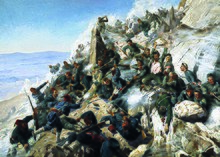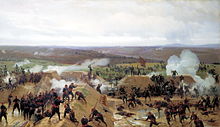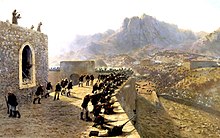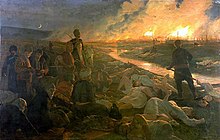Russo-Turkish War (1877–1878)
[16] Additional factors included the Russian goals of recovering territorial losses endured during the Crimean War of 1853–1856, re-establishing itself in the Black Sea and supporting the political movement attempting to free Balkan nations from the Ottoman Empire.Article 9 of the 1856 Paris Peace Treaty, concluded at the end of the Crimean War, obliged the Ottoman Empire to grant Christians equal rights with Muslims.[20][21] Fearing European intervention, the Ottoman foreign minister Mehmed Fuad Pasha was dispatched to Syria and immediately set about trying to resolve the conflict as swiftly as possible.Small as the amount of attention is which can be given by the people of England to the affairs of Turkey ... enough was transpiring from time to time to produce a vague but a settled and general impression that the Sultans were not fulfilling the "solemn promises" they had made to Europe; that the vices of the Turkish government were ineradicable; and that whenever another crisis might arise affecting the "independence" of the Ottoman Empire, it would be wholly impossible to afford to it again the support we had afforded in the Crimean war.The financial strain on the treasury forced the Ottoman government to take a series of foreign loans at such steep interest rates that, despite all the fiscal reforms that followed, pushed it into unpayable debts and economic difficulties.Russia worked to regain its right to maintain a fleet on the Black Sea and vied with the French in gaining influence in the Balkans by using the new Pan-Slavic idea that all Slavs should be united under Russian leadership.This was not easy though: the Paris peace treaty included guarantees of Ottoman territorial integrity by Great Britain, France and Austria, and only Prussia remained friendly to Russia.In March 1871, using the crushing French defeat and the support of a grateful Germany, Russia achieved international recognition of its earlier denouncement of Article 11 of the Paris Peace Treaty, thus enabling it to revive the Black Sea Fleet.Other clauses of the Paris Peace Treaty, however, remained in force, specifically Article 8 with guarantees of Ottoman territorial integrity by Great Britain, France and Austria.While in Constantinople in 1879, Protestant missionary George Warren Wood reported Turkish authorities in Amasia brutally persecuting Christian Armenian refugees from Soukoum Kaleh.[34] In Britain, where Disraeli's government was committed to supporting the Ottomans in the ongoing Balkan crisis, the Liberal opposition newspaper The Daily News hired American journalist Januarius A. MacGahan to report on the massacre stories first-hand.MacGahan toured the stricken regions of the Bulgarian uprising, and his report, splashed across The Daily News's front pages, galvanized British public opinion against Disraeli's pro-Ottoman policy.[35] In September, opposition leader William Ewart Gladstone published his Bulgarian Horrors and the Question of the East[36] calling upon Britain to withdraw its support for Turkey and proposing that Europe demand independence for Bulgaria and Bosnia and Herzegovina.[37] As the details became known across Europe, many dignitaries, including Charles Darwin, Oscar Wilde, Victor Hugo and Giuseppe Garibaldi, publicly condemned the Ottoman abuses in Bulgaria.This was accompanied by sharp public discussions about Russian goals in this conflict: Slavophiles, including Fyodor Dostoevsky, saw in the impending war the chance to unite all Orthodox nations under Russia's helm, thus fulfilling what they believed was the historic mission of Russia, while their opponents, westernizers, inspired by Ivan Turgenev, denied the importance of religion and believed that Russian goals should not be defense of Orthodoxy but liberation of Bulgaria.[46] Olender gives a breakdown of Ottoman troops in the spring of 1877 as containing 571 infantry battalions (181 of which were Nizam), 147 cavalry squadrons and 143 artillery batteries not including the fortress and garrison companies or irregulars.On 24 April 1877 Russia declared war on the Ottomans, and its troops entered Romania through the newly built Eiffel Bridge near Ungheni, on the Prut river, resulting in Turkish bombardments of Romanian towns on the Danube.On his way to Nikopol, Osman Pasha learned that the Russians had already captured the fortress and so moved to the crossroads town of Plevna (now known as Pleven), which he occupied with a force of approximately 15,000 on 19 July (NS).On 9 December, in the middle of the night the Ottomans threw bridges over the Vit river and crossed it, attacked on a 2-mile (3.2 km) front and broke through the first line of Russian trenches.Eventually Russia entered into a settlement under the Treaty of San Stefano on 3 March, by which the Ottoman Empire would recognize the independence of Romania, Serbia, and Montenegro, and the autonomy of Bulgaria.Though not as explicit, Article 16 of the Treaty of San Stefano read: As the evacuation of the Russian troops of the territory they occupy in Armenia, and which is to be restored to Turkey, might give rise to conflicts and complications detrimental to the maintenance of good relations between the two countries, the Sublime Porte engaged to carry into effect, without further delay, the improvements and reforms demanded by local requirements in the provinces inhabited by Armenians and to guarantee their security from Kurds and Circassians.In the final text of the Treaty of Berlin, it was transformed into Article 61, which read: The Sublime Porte undertakes to carry out, without further delay, the improvements and reforms demanded by local requirements in the provinces inhabited by Armenians, and to guarantee their security against the Circassians and Kurds.[103] According to Ottoman official records, the total number of refugees from the lands ceded in 1878 to the Principality of Bulgaria, Eastern Rumelia, Serbia, Romania and Austria-Hungary (from Bosnia) from 1876 to 1879 stands at 571,152 people: 276,389 in 1876, 198,000 in 1877, 76,000 in 1878 and 20,763 in 1879.1.5 million Turks who had reportedly perished or been forced to migrate according to both Karpat and İpek – whose estimates would also necessarily mean that no Muslims whatsoever remained in either the Principality of Bulgaria, Eastern Rumelia, Serbia or Romanian Dobruja.[116] The perpetrators of those massacres are also disputed, with Justin McCarthy claiming that they were carried out by Russian soldiers, Cossacks as well as Bulgarian volunteers and villagers, though there were few civilian casualties in battle.[121] In this connection, it is important to note that Justin McCarthy, who is the author of the estimates above and has been requoted by both Hupchik and Howard, is an Armenian Genocide denialist who has been criticised severely by many of his colleagues for whitewashing Ottoman history.[127][128][129] The most notable massacre of Bulgarian civilians during the Russo-Turkish War took place during the Battle of Stara Zagora in July 1877, when Gurko's forces had to retreat back to the Shipka pass.[136] Later on in the campaign, the Ottoman forces planned to burn the town of Sofia after Gurko had managed to overcome their resistance in the passes of Western part of the Balkan Mountains.Both Russia and the Ottoman Empire had signed the First Geneva Convention (1864), which made the Red Cross, a colour reversal of the flag of neutral Switzerland, the sole emblem of protection for military medical personnel and facilities.[148] The novel The Doll (Polish title: Lalka), written in 1887–1889 by Bolesław Prus, describes consequences of the Russo-Turkish war for merchants living in Russia and partitioned Poland.


























Great Eastern CrisisRusso-Turkish warsAction off MăcinBattle of Shipka PassSiege of PlevnaBattle of TashkessenBalkansCaucasusRussian EmpireAssyriansBulgarian LegionRomaniaSerbiaMontenegroBulgarian rebelsSerbian rebelsOttoman EmpireKurdish volunteersAlbanian volunteersCircassian volunteersPolish LegionImamate rebelsAlexander IIGD. NikolaiGD. MikhailDmitry MilyutinIosif GurkoMikhail Loris-MelikovGrigol DadianiArshak Ter-GukasovPrince AlexanderPyotr VannovskyMikhail DragomirovMikhail SkobelevIvan LazarevEduard TotlebenNikolai StoletovVladimir DobrovolskyCarol IMilan IKosta ProtićNikola IAbdul Hamid IIIbrahim PashaHamdi Pashaİsmail PashaMuhtar PashaOsman PashaŞakir PashaSüleyman PashaHasan PashaHüseyin PashaAli PashaHobart PashaAbdülkerim PashaEyüb PashaFuad PashaRıza PashaBaker PashaGiranduk BeyRussiaKızıl TepeSimnitzaSvistovNikopolStara ZagoraMăcinPlevnaLovchaShipka PassAladzhaGorni-DubnikErzurumTashkessenPlovdivHarmanliHerzegovina uprising (1875–1877)April Uprising of 1876Razlovtsi insurrectionReichstadt AgreementSerbian–Ottoman Wars (1876–1878)Montenegrin–Ottoman War (1876–1878)First Constitutional EraConstantinople ConferenceBudapest Convention of 1877Romanian War of IndependenceProvisional Russian Administration in BulgariaTreaty of San StefanoCyprus ConventionExpulsion of the Albanians, 1877–1878Congress of BerlinKumanovo uprising1878 Macedonian rebellionEpirus Revolt of 1878Cretan revolt (1878)Treaty of Berlin (1878)Austro-Hungarian campaign in Bosnia and Herzegovina in 1878Kresna–Razlog uprising1568–15701672–16811686–17001710–17111735–17391768–17741787–17921806–18121828–18291853–18561914–19181916–1917Crimean WarBlack SeaRomanian War of Independence (1877–1878)ConstantinopleBudjak1856 Paris Peace TreatyEdict of Gülhane1860 Mount Lebanon civil warMaroniteBeirut vilayetcivil warOttoman foreign ministerMehmed Fuad PashaBritish joined the French expeditionMoni ArkadiouCretan Revolt
